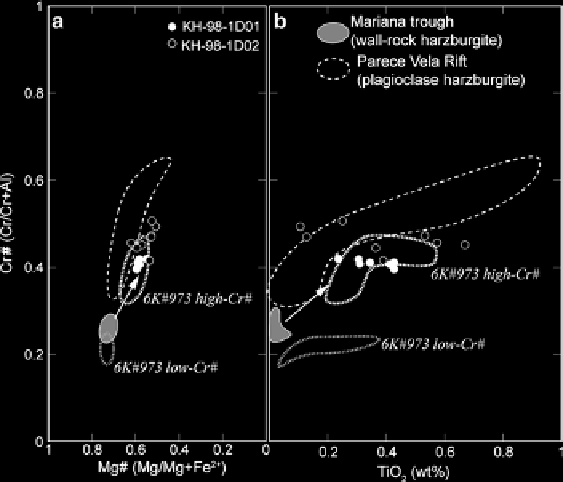Geoscience Reference
In-Depth Information
Fig. 4
Chemical compositions of spinel in plagioclase-bearing peridotites from the southern
Marianas, with references to those from other areas of the Philippine Sea (Ohara et al.
2002, 2003
;
Ohara
2006
; Michibayashi et al.
2009
). The
arrow
indicates the trend for impregnating melts
in peridotites from the Mariana Trough. (
a
) Cr# (Cr# = Cr/(Cr + Al)) versus Mg# (Mg# = Mg/
(Mg + Fe
2+
)), and (
b
) Cr# versus TiO
2
wt%
These facts make it difficult to evaluate the origin of the plagioclase. However, we
propose that impregnating melts influenced the crystallization of plagioclase in
peridotites from the fault at 144°E, an idea first mentioned by Bloomer and
Hawkins (
1983
) and more recently by Michibayashi et al. (
2009
). We base this
proposal on the following arguments.
1. Spinel in abyssal peridotites usually contains low or negligible amounts (<0.25
wt%) of TiO
2
(Dick and Bullen
1984
). Therefore, it is accepted that Ti-enrichment
in spinel results from reactions caused by impregnating melts (e.g., Dick and
Bullen
1984
; Cannat et al.
1990
; Girardeau and Francheteau
1993
; Niida
1997
;
Pearce et al.
2000
).
2. The TiO
2
contents of spinel in peridotites from the fault at 144°E are higher than
those from the Mariana Trough, and similar or only slightly lower than those in
the P (plagioclase)-type peridotites from the Parece Vela Rift (Fig.
4
).
3. Spinel in the P-type peridotites from the Parece Vela Rift has compositions that
are thought to have been affected by an impregnating melt, and the spinel is
richer in TiO
2
than spinel in impregnation-free F (fertile)-type peridotites (Ohara
et al.
2002
; Ohara
2006
). The range of TiO
2
contents in spinel from peridotites
along the 144°E fault is similar to that in the P-type peridotites from the Parece
Vela Rift (Fig.
4
). Michibayashi et al. (
2009
) found both high- and low-Cr#

Search WWH ::

Custom Search